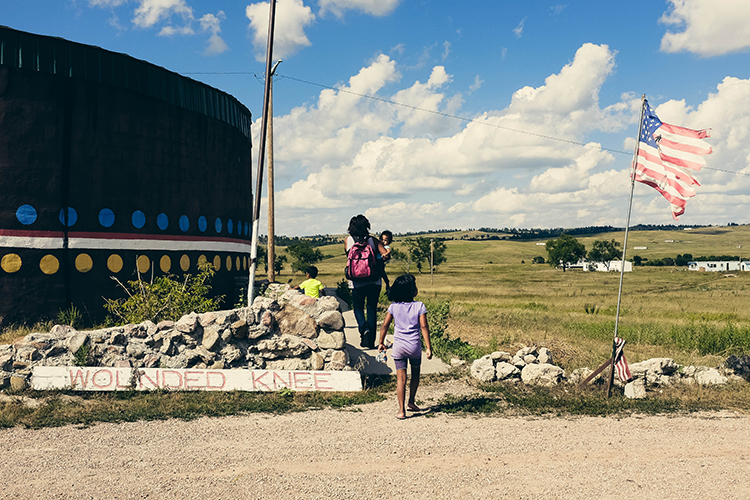In the fight for racial justice, Native stories should not be ignored
Visiting Native studies scholar will delve into the origins of race in America
September 25, 2020
Watch Friday’s Berkeley Conversations: “Race —The power of an Illusion Part 2, The Story We Tell.” The event examined the impact and origins of the concept of race.
Race in America was socially constructed —based on white supremacy— and cannot exist without the creation of a racial hierarchy that leads to violence against communities of color.
That’s according to University of Alberta professor Kim TallBear, who teaches in the school’s Faculty of Native Studies department. A member of the Sisseton-Wahpeton Oyate tribe in South Dakota, TallBear was one of several panelists examining the history of race in America during a livestreamed Berkeley Conversations event today (Friday, Sept. 25) at 1 p.m.

University of Alberta Associate Professor Kim TallBear’s research focuses on genetic science and the notions of race and indigeneity.
Attendees watched the documentary “Race: The Power of an Illusion: (Part2) The Story We Tell,” which was followed by a one-hour discussion and Q&A session.
Sponsored by Berkeley’s Othering and Belonging Institute, the screening and talk was the second in a three-part series delving into the concept of race and its origins in America.
“We have to understand history better,” said TallBear, whose research focuses on genetic science and the notions of race and indigeneity. “If we understand how we have each been racialized differently, to support different parts of white supremacy, it’s really helpful for having conversations about how we can support each other’s causes.”
TallBear spoke with Berkeley News about where Native stories fit in the discussion of race and racism and how understanding the history and stories of Native and indigenous peoples can help in the fight for racial justice.
Berkeley News: Why is it important to understand the concept of race and its history?
TallBear: The truth is, if you have race, there is no way to have race without the racial hierarchy that people are put into. There is resulting violence that comes from the creation of that hierarchy. Contextualizing it historically helps people understand why it’s imperative that we continue to interrogate and denaturalize race.
If race is thought to be natural and found in nature, people get comfortable, especially people who benefit from racial hierarchy, and we can get complacent about the need to tackle it and dismantle it.
For many decades, we’ve had scholarship and history that have interrogated and worked to denaturalize race. And you still have geneticists coming along in 2016 saying they discovered race is genetic.
The social sciences and humanities have been studying that for a long time, and I don’t know that it’s made any difference in terms of racial violence.
What it has done is given those who are subjected to racial violence ways to find alternatives that we can suggest for anti-racist organizing and institution-building in our communities.
I’m not sure that all of the analysis of race as a social construct has lessened white people’s racism; it has certainly benefited those who are the object of racism, in terms of the conversations and the successes that we can enact within our communities.
The way I look at it is that white racism in the United States is like a boxer: It has got a lot of slick moves and can move around your jab and come back with another way to be racist. That’s what we see throughout history, a changing face of racism.
What does the changing face of racism look like now, for Native peoples?
When Elizabeth Warren came out and claimed to have Native American DNA, it was an example of the desire of many Americans to find an Indian in their family tree. That is often seen in the mainstream media as appreciation for Native people in history, or as multicultural inclusion.
But in order to claim to be Cherokee or Native, based on an ancestor from long ago, it’s the same thing as saying we’re all African, based on the fact that all humans share DNA that they could trace back to the ancestors that came out of the continent we now call Africa.
These ideas get respun in the 21st century as anti-racism, but they’re both predicated on the idea that there is an evolutionary hierarchy. By doing that, Africans stand in for ancient humans. A Native ancestor no longer has to exist in the present, as long as they exist in the body of the person who claims them.
Both of these things are essentially white people just feeling that they have a right to claim those ancient ancestors — therefore, they have a right to claim the land, they have a right to claim our DNA. They have a right to claim our power, they claim to have the right to do genetic research on exploited living populations now.
They have a right to control the discourse in the story of human evolution.
And then what they do is they take all of that genetic knowledge, which they mined from the bodies of less powerful living subjects with Black and brown skin, and they turn around and make a story of human connection and human relatedness in which they are still controlling the story, the biological raw materials of research and the institutions that research comes from.
Do you think that Native peoples’ stories are ignored in the discussion of race and racism?
The racial imagination of the U.S. is very much a white-Black kind of hierarchy. Race gets more complicated in the U.S. when you look at the triad of white, red and Black. In Canada, especially where I live on the prairie, it’s a lot like where I grew up in South Dakota: The racial dividing line is more visibly red and white.
Back when I was in graduate school, the book “Racial Formation in the United States” was a key literary work that covered the role of anti-Black racism in the law. But there was literally one line in the book about Native peoples.
So, yes, our stories are often seen as an afterthought in this discussion. Our stories are also often ignored in the media.

A native family in South Dakota’s “Wounded Knee” land. TallBear, who lived in the area prior to moving to Canada, said their stories are often ignored in the discussion of race in America. (Photo Courtesy of flikr/Bartosz Brzezinski)
When stories about Native communities are covered, do you think the news media tells them accurately?
The coverage of Indian country by mainstream media is atrocious. It is completely out of touch with tribal life. They have these weird stereotypes of the “vanishing Indian” that influence all of their coverage.
They’re looking at everything through their stereotypical lenses of what Native people should look like and be.
I think our issues don’t get picked up nationally in the same way, so people get to know what’s happening through activist communities and in Native and indigenous media. With those sources, you’re going to get those stories about the missing and murdered indigenous women along oil pipeline camps, right away.
It takes a long time for that story to hit the New York Times or the L.A. Times.
I do think that there is a lot of information out there now that can be accessed. For people that want to know more about Native people and their communities, they should start following indigenous media.
In the United States, there’s the Indian Country Today media network, and they have just moved their headquarters down to Arizona State University’s school of journalism. There’s a lot of members of the Native American Journalists Association that are involved with them. They tend to be very liberal and mainstream, but they are pretty good at covering major stories in Indian communities.
There’s also the Aboriginal Peoples Television Network in Canada that also covers many U.S. stories so much better than mainstream media covers indigenous issues. There’s also Native America Calling, which is a weekly radio show out of Albuquerque that covers current events.
There are various alternative media that tell the story of Indian country well. You just have to seek them out.
Do you think understanding Native stories and history is important for other communities fighting for racial justice today?
Native history, and the struggles and the issues that other communities are going through right now, relate in the larger picture of how white supremacy works. If we better understand each other’s particular struggles, we can work better together.
I try to avoid the entanglements between how Native people are racialized differently in relationship to white versus Black people. This is why I would not rank the experiences of Native and Black people as “one is worse than the other.”
They’ve both resulted in terrible amounts of violence in relation to white supremacy, but different tactics were done to Native and Black people.
We were racialized differently.
If we understand how we have each been racialized differently, to support different parts of white supremacy, it’s really helpful for having conversations about how we can support each other’s causes. We have to understand history better.
